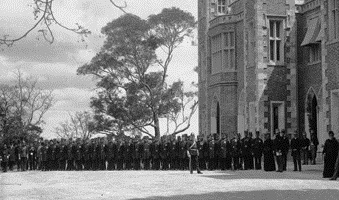|
The name pensioner guards is a bit misleading as these days we tend to think of pensioners as being aged 65 and upward. These men were former soldiers who had been discharged from the
military and were on a pension but were still young, fit and healthy.
Once it was decided to send convicts to W.A. to act as a source of cheap labour, there was a need for guards to ensure that the convicts were kept in order. Ex-soldiers were offered free passage,
six months employment, and a grant of land (3-20 acres). The men were paid a retainer and were stationed wherever the government had a need for them.
In order to encourage these men to remain in the colony once their time as guards was complete, they were offered grants of 10 acre blocks which they would lease for 7 years and then the land would
become freehold. They were also allowed access to convict labour to help clear the blocks and were given 10 pounds cash.
Not all the men who travelled over with the convicts remained as guards once they arrived. Many sought general employment but were always available if required to the government in times of unrest.
The scheme ended in 1864 by which time over 1100 guards and their families (totalling around 2500 people) had arrived in the colony.
Captain John Bruce, arrived with the second detachment aboard the Hashemy, was appointed Staff Officer to the Enrolled Pensioner Force which was the original name given to the unit.
In 1863 a large pensioner's barracks building was established at the top of St George's Terrace in Perth. When completed the barracks contained 120 rooms, a hospital, magazine, and other facilities.
The uniform consisted of dark blue-black trousers with a scarlet stripe down the leg; knee length dark blue frock-coats with red facings, dandified epaulettes and a regulation shako (hat).
No original uniforms remain but there is a replica at Fremantle Prison.
Captain C. Finnerty replaced John Bruce as commander and remained in that position until 1872 when Colonel E.D. Harvest, assumed command. (1)
In November 1880 the Enrolled Pensioner Force was abolished and Enrolled Guard was established. Captain M.S. Smith became the new unit's commander.
The Enrolled Guard was disbanded in March 31 1887.
ARMS AND EQUIPMENT
Pattern 39 or 42 muskets and later the Snider breech loading Rifles were used. Muskets were equipped with socket bayonets.
These weapons were also equipped with a scabbard, muzzle stopper and cap with chain. There was also a black power nipple wrench
that was used to unscrew nipples that held percussion caps.
Clothing consisted of black Blucher boots, Shako (hat), crimson sash (officers), blue trowsers, blue with a 1/4" red stripe, double breasted frock coat with brass buttons and red regimental facings,
grey Kersey greatcoat, black pouch with zinc oil bottle, black belt used as a cartridge box sling, black waist belt, waist belt buckle with regimental crest,
black leather cartridge box -with 50 rounds of ammunition, black pouch, for percussion caps, black musket sling plus a whistle and chain for senior NCO's and Officers.
COMMANDERS
Lt-Colonel John Bruce : 11 Nov 1854 to 4 Nov 1870
Major Robert Henry Crampton : 5 Nov 1870 to 14 Aug 1871
Captain Charles Finnerty : 15 Aug 1871 to 14 Aug 1872
Lt-Colonel Edward Douglas Harvest : 15 Aug 1872 to 17 Nov 1880
(1) One source quotes Charles Finnerty as taking command after John Bruce but another shows Robert Henry Crampton as commander between Bruce and Finnerty.
|







